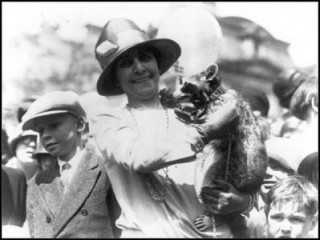
Grace Ann Coolidge biography
Date of birth : 1879-01-03
Date of death : 1957-07-08
Birthplace : Burlington, Vermont, United States
Nationality : American
Category : Famous Figures
Last modified : 2010-08-03
Credited as : First lady of the United States, wife of President Calvin Coolidge,
0 votes so far
Calvin Coolidge was thirtieth president of the United States, but his wife was largely responsible for his political successes. Grace Anna Goodhue Coolidge worked hard to promote her husband's career, and tirelessly brought all her charm into play. She also tried to make sure her children had a normal upbringing. While her husband was busy with political responsibilities, she played baseball with their two sons in the backyard.
Charmed the Washington Crowd
Born January 3, 1879 in Burlington, Vermont, Coolidge was the only child of steamboat inspector and mechanical engineer Andrew Issachar Goodhue and his wife Lemira Barret. Coolidge earned her degree from the University of Vermont in 1902 and went on to get training for teaching the deaf. The following fall she began teaching at the Clarke School for the Deaf in Northampton, Massachusetts, where she continued to work for three years.
While she was teaching at Clarke, Coolidge met a young attorney. He was a member of the Congregational Church that she attended and he associated with the same people she socialized with at boating, picnicking, and whist-club activities. Rather reserved and quiet, Calvin Coolidge was the perfect foil for her own vivacious nature.
Married October 4, 1905, Coolidge and her husband lived in her parents' home. Coolidge's husband was a struggling young lawyer with his way to make in the world, so the family was not ostentatious and lived within its means. Before their first son was born, the Coolidges moved into half of a duplex. Their second son was born in 1908, which meant the family budget had to be strictly watched. Even when her husband became governor, Coolidge and her family stayed in the duplex to save expenses.
Because her husband was somewhat shy, Coolidge made every effort to be cheerful and friendly. She was very warm and open while he was reserved. When Calvin Coolidge became vice president in 1921, her sincerity captured the hearts of the people she met in the nation's capital. Despite the fact that her husband was rather austere, his fondness for his wife led him to be a little less frugal when she was concerned. Her vivacity and wit were set off by fashionable clothing, an extra expense her thrifty husband seemed very willing to pay.
Became First Lady
Coolidge came to the White House when her husband became president in 1923. Following the excesses of the Harding administration, her husband was anxious to set an example for seriousness. He did not allow his wife to dance; he also did not allow her to publicly discuss political issues on the radio or give interviews.
None of these restrictions seemed to inhibit Coolidge's high spirits. She even quipped at a luncheon given for newspaperwomen that she must not speak to the press per her husband's orders; meanwhile, she gave a five-minute speech in sign language.
While Coolidge never liked publicity, her wit and warmth placed her in the public eye. Her role was to offset the cold demeanor of her husband. He was seen as somewhat stern by America's public; Walter Lippmann once congratulated his conservative approach as a talent for doing nothing.
To all outside observers Coolidge was a good domestic partner for her husband, but within she was full of life and play. She seemed to realize that the role of first lady was distinct and separate from her own personality when she said, "This was I and yet not I -- this was the wife of the President of the United States and she took precedence over me; my personal likes and dislikes must be subordinated to the consideration of those things which were required of her," as quoted on the White House official website.
Coolidge never forgot her obligations. In 1924, when her son died from blood poisoning at age 16, Coolidge concentrated on her duties as first lady. She formed an advisory committee to remodel the White House mansion and refurbished the Green Room. She also served as an example for women by voting, staying fit with long walks, and personally meeting with outstanding women in different career fields. She supported the Red Cross, Easter Seals, and the Association for the Aid of Crippled Children.
Coolidge used her influence as first lady to further the welfare of others. For her efforts, she received a gold medal from the National Institute of Social Sciences. In 1931, she received recognition as one of America's twelve greatest living women. Helen Keller called her "responsive to every human need."
Lost Her Husband
The warmth and joy Coolidge brought to her husband's life were very dear to him, as he wrote in his autobiography (according to the White House official website): "For almost a quarter of a century she was borne with my infirmities, and I have rejoiced in her graces." During his retirement, the former president continued to cherish the domestic bliss his wife brought to his home.
After her husband's death in January 1933, Coolidge moved from The Beeches, a vast house in Northampton with large grounds, to a smaller house. She spent the rest of her life fulfilling her love for new experiences.
Although Coolidge suffered the loss of a son and the loss of a husband many years before her own death, she never lost her sense of adventure. In her widowhood, she took an airplane ride and went to Europe for the first time. She had articles and poems published in Good Housekeeping and American Magazine. She also served as a trustee of the Clarke School.
Coolidge died July 8, 1957 in Northampton, Massachusetts. She was survived by her son, John.
AWARDS
National Institute of Social Sciences Gold Medal.
















